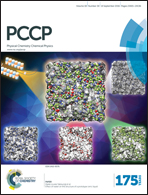C-terminal tail insertion of Bcl-xL in membrane occurs via partial unfolding and refolding cycle associating microsolvation†
Abstract
Bcl-xL, a member of the Bcl-2 family of proteins, remains distributed over the cytosol and the mitochondrial membrane, maintaining a balance between apoptosis and the survival of the cell. Passage to the membrane is essential for its biological functions (e.g. to antagonize pro-apoptotic proteins of the Bcl2 family), which is known to be initiated by the insertion of the C-terminal segment into the membrane. This tail, composed of ∼24 residues, is reported to act as a pseudo-inhibitor of the protein itself, adapting a helical conformation. It gets released from the confinement when Bcl-xL approaches the membrane. This article reports the events associated with the insertion of the helical tail into an explicitly modeled all-atom membrane, which reveals a partial unfolding to refolding cycle of the peptide, correlating with the early insertion, to a fully inserted state. The polar interactions have been found to have a dominant role in steering the peptide towards the membrane at the desired orientation. The landscape of the potential of mean force (PMF) is consistent with the proposed mechanism. Molecular dynamics further brings the insight that the peptide insertion is associated with the encapsulation of a thin water layer around the peptide throughout the course of insertion, which motivates the protein to refold once the insertion is complete.


 Please wait while we load your content...
Please wait while we load your content...